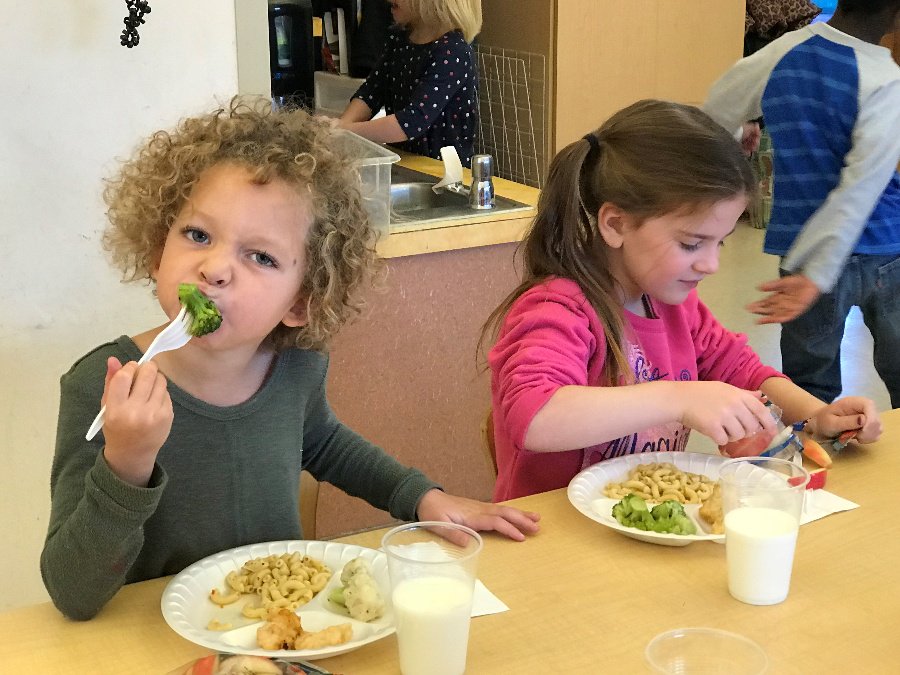Family-Style Fosters Healthy Eating Habits for Young Children
Eating family-style meals and snacks is recognized as a best practice in child care settings of all types—large or small centers, in-home providers, preschools, or church child cares. Family style is all about children and supervising adults sharing a meal together, with children encouraged to serve food themselves.

To follow the best practice, caregivers place enough food on the table to allow each child and adult to take the full regulatory portion of food required by the Child and Adult Care Food Program (CACFP) or State Licensing Rules. Children are allowed to choose how much of each food they serve themselves, or if they will take any of the food at all.
Family style meals help children try new foods by allowing them to feel in control of their eating. Supervising adults can encourage healthy eating habits by role modeling them.
Additional benefits of family style meals
- Teach children to self regulate portion sizes according to their level of hunger
- Enhance development of fine motor, language, and social skills
- Provide opportunities for children to learn about food, food groups, and how food helps growth
- Build lifelong skills such as food preparation and presentation, as children participate in the entire process
- Build self-esteem and develop independence as children learn new skills
Sample mealtime routine
- Caregiver calls for helpers. Children have daily jobs.
- Activity signals transition—e.g., song.
- Group breaks for bathroom and hand washing.
- Children sit at table as food is placed.
- Caregivers sit and eat with children, encouraging conversation and sharing food lessons.
- Children and caregivers clean up own plates/place settings.
- Children move to transition activity while others finish eating—e.g., quiet books or puzzles.
What materials will you need?
- Serving bowls/platters of appropriate sizes (nonbreakable) for children to lift and pass
- Serving dishes that do not conduct heat and are not too hot to pass
- Small size scoops, one-piece plastic tongs, and short-handled hard plastic serving spoons
What rules and expectations can be established?
- We eat together at the table.
- We wait until everyone is ready before we begin.
- We serve ourselves and then pass food with both hands.
- We keep food over the table when passing it.
- We hold the bowl by the sides to keep fingers out of the food.
- We eat the food that’s on our plate/bowl.
Practice activities
You can set up play stations or lead small group activities to teach and practice meal time skills.

Serving utensils practice
Practice with scoops, tongs, and short-handled hard plastic serving spoons. Children can scoop dry goods such as beans or sand.
Pouring practice
Practice pouring
from a small pitcher into child-size cups. You might begin with pretend
practice, then transition to dry goods and eventually water.
Cleanup practice
Practice cleaning up table and
floor using sponges, cloths and mini mop. You can begin with pretend
play and transition to practicing with water.
Tips for transitioning to family style
- Practice passing bowls of dry beans, dry rice, or pitchers of water with the children before implementing during meal service.
- Start small with easy to serve items, like buns or rolls, then expand to other foods one at a time.
- Keep towels or napkins nearby for quick cleanup of spills.
- Keep extra serving utensils on hand in case someone drops or inappropriately touches those in use.
Family style dining promotes comfortable and enjoyable meals, independence, portion control, and other healthy eating habits. Children see food that looks good, see others enjoying it, and know they can have some.
At School, too!
We know that ages 2-5 are instrumental in shaping lifelong eating habits, and what happens during the school-aged years has impact, too. Learn about what schools are doing to encourage healthy eating—and how that affects academic achievement—in our guide, Healthy Students Achieve More.

Topics: Child Care, Healthy Eating
Subscribe for more
Want more ideas for healthy schools, workplaces, child care providers, and families? Subscribe to our blog for weekly tips delivered right to your inbox!
Healthy Eating Plays a Role in Academic Success NEXT »
Make Physical Play Part of Every Day
